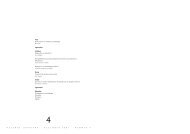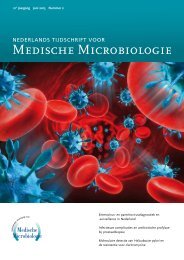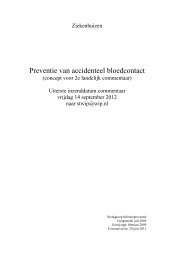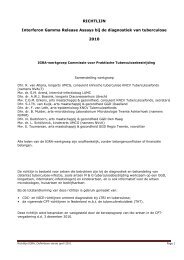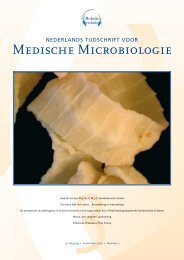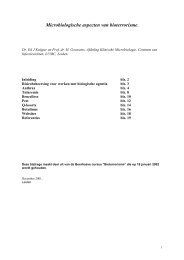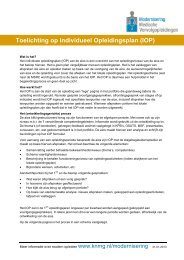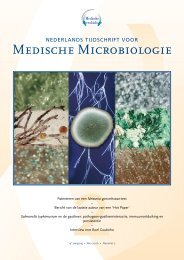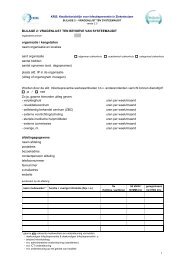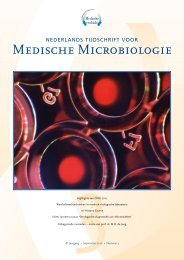Thema: Diabetes mellitus en infectieziekten Het ... - NVMM
Thema: Diabetes mellitus en infectieziekten Het ... - NVMM
Thema: Diabetes mellitus en infectieziekten Het ... - NVMM
- No tags were found...
You also want an ePaper? Increase the reach of your titles
YUMPU automatically turns print PDFs into web optimized ePapers that Google loves.
in household members of pig- and veal farmers arelower than those in farmers themselves (4-8% versus20-40%), but substantially higher than in the g<strong>en</strong>eralDutch population (0.1%). The aim of this prospectivecohort study was to further elucidate the dynamics anddeterminants of LA-MRSA carriage in household membersof pig farmers. In total, 171 household members living on50 Dutch pig farms were included in the study. On sixsampling mom<strong>en</strong>ts in a one-year period, repeated humanand <strong>en</strong>vironm<strong>en</strong>tal samples were tak<strong>en</strong>, and questionnaireswere completed. The mean MRSA preval<strong>en</strong>ce inhousehold members per sampling mom<strong>en</strong>t was 10%,4% of household members were persist<strong>en</strong>tly carryingMRSA. All stables, 63% of the home <strong>en</strong>vironm<strong>en</strong>ts, and74% of dogswere MRSA-positive. Multivariate analysisid<strong>en</strong>tified working in the stables (preval<strong>en</strong>ce ratio (PR)2.11 per 10 hours per week, p-value 0.00), working withsows (PR 1.97, p 0.00), and pres<strong>en</strong>ce of an MRSA-positivepig farmer (PR 4.62, p 0.02) as indep<strong>en</strong>d<strong>en</strong>t risk factorsfor a MRSA positive sample during the study. MethicillinsusceptibleStaphylococcus aureus (MSSA) nasal carriagewas a significant protective factor (PR 0.50, p 0.02). Thiscohort study shows that MSSA carriage protects householdmembers of pig farmers from MRSA acquisition, and thatcontact with pigs and MRSA positive pig farmers are themost important risk factors. Whether human-to-humantransmission occurs, or LA-MRSA acquisition is alwaysdue to animal contact, remains to be disclosed.Livestock-associated MRSA does not add substantiallyto the disease-burd<strong>en</strong> caused by StaphylococcusaureusB.A.G.L. van Cleef 1,2 , B.H.B. van B<strong>en</strong>them 1 , A.P.J. Ha<strong>en</strong><strong>en</strong> 1 ,J. Mon<strong>en</strong> 1 , T. Bosch 1 , J.A.J.W. Kluytmans 2,31 C<strong>en</strong>tre for Infectious Disease Control Netherlands, RIVMNational Institute for Public Health and the Environm<strong>en</strong>t,Bilthov<strong>en</strong>, 2 Laboratory for Medical Microbiology and InfectionPrev<strong>en</strong>tion, St. Elisabeth Hospital, Tilburg, 3 Departm<strong>en</strong>t ofMedical Microbiology and Infection Control, VU UniversityMedical C<strong>en</strong>tre, AmsterdamWe describe the incid<strong>en</strong>ce of livestock-associatedmethicillin-resistant Staphylococcus aureus (LA-MRSA)bacteraemia compared to bacteraemia with other MRSAvariants and all S. aureus. This shows the limited burd<strong>en</strong>of disease caused LA-MRSA.MRSA is a worldwide problem in both hospitals andcommunities all over the world. Since 2005 a new MRSAclade has emerged, with a reservoir in pigs and veal calves:LA-MRSA. We wanted to estimate the curr<strong>en</strong>t incid<strong>en</strong>ceof invasive infections due to LA-MRSA using the nationalantibiotic resistance surveillance system ISIS-AR from theyear 2009 in the Netherlands. We found a low incid<strong>en</strong>ceof LA-MRSA bacteraemia episodes, compared to bacteraemiascaused by MRSA in g<strong>en</strong>eral or all S. aureus(0.04, 0.18 and 19.3 episodes of bacteraemia per 100,000inhabitants per year, respectively). Our findings show thatthe disease-burd<strong>en</strong> of MRSA, including LA-MRSA, is verylow (approximately 1%) compared to the total burd<strong>en</strong> ofdisease caused by S. aureus. This may be explained by acombination of reduced virul<strong>en</strong>ce of the strain involved,the effectiv<strong>en</strong>ess of the search and destroy policy forMRSA in the Netherlands and the good health status ofthe population that is affected with LA-MRSA. At pres<strong>en</strong>tthe impact of MRSA, including LA-MRSA, for the Dutchpopulation is very limited.Preval<strong>en</strong>tie van Staphylococcus aureus-neusdragerschapbij chirurg<strong>en</strong> <strong>en</strong> chirurg<strong>en</strong> in opleidingin NederlandJ.L.A. van Vugt 1 , R.J.S. Coel<strong>en</strong> 1 , J.P.M. Derikx 1,3 , D.W. vanDam 2 , J.H.M.B. Stoot 11 Afdeling Chirurgie, Orbis Medisch C<strong>en</strong>trum, Sittard,2 afdeling Medische Microbiologie, Orbis Medisch C<strong>en</strong>trum,Sittard, 3 afdeling Chirurgie, Maastricht Universitair MedischC<strong>en</strong>trum, MaastrichtStaphylococcus aureus-neusdragerschap bij patiënt<strong>en</strong> ise<strong>en</strong> bek<strong>en</strong>de bron voor post-operatieve wondinfecties.<strong>Het</strong> is onbek<strong>en</strong>d in welke mate S. aureus neusdragerschapbij zorgverl<strong>en</strong>ers bijdraagt aan post-operatievewond infecties. Doel van deze studie was om het perc<strong>en</strong>tageS. aureus-neusdragerschap bij e<strong>en</strong> grote groep chirurg<strong>en</strong><strong>en</strong> chirurg<strong>en</strong> in opleiding in Nederland te beschrijv<strong>en</strong>.Tijd<strong>en</strong>s de Chirurg<strong>en</strong>dag<strong>en</strong> in mei 2012 werd<strong>en</strong> chirurg<strong>en</strong>(n = 216) <strong>en</strong> chirurg<strong>en</strong> in opleiding (n = 148), 256 mann<strong>en</strong><strong>en</strong> 108 vrouw<strong>en</strong>, vrijwillig gescre<strong>en</strong>d op S. aureus-neusdragerschap.De controlegroep bestond uit patiënt<strong>en</strong> reguliergescre<strong>en</strong>d op S. aureus-neusdragerschap (n = 1990).De preval<strong>en</strong>tie van S. aureus-neusdragerschap onderchirurg<strong>en</strong> (in opleiding) bedroeg 45,1%, hetge<strong>en</strong>significant hoger was dan in onze controlegroep (27,1%,p < 0,001). Mannelijke chirurg<strong>en</strong> in opleiding (49,4 %)<strong>en</strong> mannelijke chirurg<strong>en</strong> met 0-10 jaar ervaring (60,0 %)hadd<strong>en</strong> het hoogste perc<strong>en</strong>tage S. aureus-neusdragerschap.De laagste perc<strong>en</strong>tages S. aureus-neusdragerschap werd<strong>en</strong>gevond<strong>en</strong> bij vrouwelijke chirurg<strong>en</strong> meer dan 10 jaarpraktiser<strong>en</strong>d (25,0 %) <strong>en</strong> mannelijke chirurg<strong>en</strong> meer dan20 jaar praktiser<strong>en</strong>d (34,9 %).Concluder<strong>en</strong>d laat deze studie zi<strong>en</strong> dat S. aureus-neusdragerschapin Nederland bij chirurg<strong>en</strong> (in opleiding) in45,1 % voorkomt, significant hoger dan de controlegroep,met de hoogste perc<strong>en</strong>tages bij mannelijke chirurg<strong>en</strong> met0-10 jaar ervaring <strong>en</strong> mannelijke chirurg<strong>en</strong> in opleiding.Ned Tijdschr Med Microbiol 2012;20:nr4185



